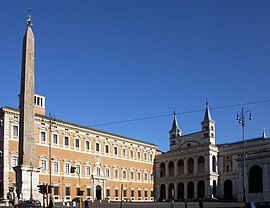
Back قصر لاتيرانو Arabic Латэранскі палац Byelorussian Латерански дворец Bulgarian Palau del Laterà Catalan Lateránský palác Czech Lateranpalast German Ανάκτορο του Λατερανού Greek Palacio de Letrán Spanish Lateraani palee Estonian Laterango jauregia Basque
| Lateran Palace | |
|---|---|
 St. John in Lateran square with the Lateran Palace (left) and the Archbasilica of Saint John Lateran (right) and the Obelisk of Thutmosis III in front | |
 Click on the map for a fullscreen view. Lateran marked at center, and with Vatican in gray outline at left. | |
| General information | |
| Location | St. John's Square in Lateran on the Caelian Hill, Rome, Italy |
| Coordinates | 41°53′12″N 12°30′19″E / 41.8867°N 12.5053°E |
| Website | |
| palazzolateranense.com | |
The Lateran Palace (Latin: Palatium Lateranense; Italian: Palazzo del Laterano), formally the Apostolic Palace of the Lateran (Latin: Palatium Apostolicum Lateranense), is an ancient palace of the Roman Empire and later the main papal residence in Rome.
Located on St. John's Square in Lateran on the Caelian Hill, the palace is adjacent to the Archbasilica of Saint John Lateran, the cathedral church of Rome. The wealthy Lateran (Laterani) family held the palace estate during the Roman Empire, and the estate eventually came into the hands of the Emperor Constantine. From the fourth century, the palace was the principal residence of the popes, and continued so for about a thousand years until the Apostolic Residence ultimately moved to the nearby Vatican. The palace is now used by the Vatican Historical Museum, which illustrates the history of the Papal States. The palace also houses the offices of the Vicariate of Rome, as well as the residential apartments of the Cardinal Vicar, the pope's delegate for the daily administration of the diocese. Until 1970, the palace was also home to the important collections of the Lateran Museum, now dispersed among it and other parts of the Vatican Museums.
The building that stands today, after many waves of construction and destruction since Roman times, is nearly all from the rebuilding begun in the 1580s to the designs of Domenico Fontana. This is a rectangular building with a central courtyard, higher but less sprawling and so smaller than the medieval palace, of which only fragments remain, themselves largely rebuilt later. The Leonian Triclinium, the end wall of a great medieval hall, and the Santa Scala or "Holy steps" are the largest of these. These are now incorporated into a separate building across the square from the main palace.
Following the Lateran Treaty of 1929, the palace and adjoining basilica are extraterritorial properties of the Holy See.[Notes 1]
Cite error: There are <ref group=Notes> tags on this page, but the references will not show without a {{reflist|group=Notes}} template (see the help page).